How does the heart beat?
The heartbeat is controlled by electricity. Special cells called pacemakers release bursts of electrical energy that travel through the heart muscle, causing it to contract. When the muscle contracts, blood is pumped through the heart. Some things can make the heart beat faster, such as exercise, crying, illness, pain or fever. In these examples, the electrical energy that is running through the heart follows a regular (or usual) pathway. In other conditions, tachycardia, or a fast heartbeat, is caused because there is an abnormal electrical pathway or abnormal pacemaker cells.
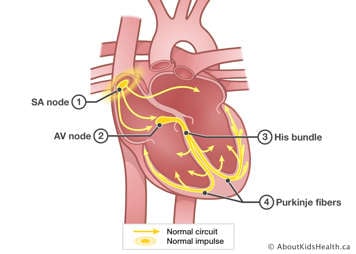
What is an arrhythmia?
An arrhythmia (also called dysrhythmia) refers to what is usually an abnormal heartbeat. The heart rate can be fast, slow or irregular, taking into consideration age and activity. For example, a newborn's heart normally beats much faster than a five-year-old child's heart. What is considered a fast heart rate in a newborn is different than what is considered a fast heart rate in an older child.
An arrhythmia that causes a fast heartbeat is referred to as tachyarrhythmia. This can last for seconds, minutes or even hours, depending on how serious it is. Symptoms include feeling dizzy, weak and generally uncomfortable.
There are two basic types of tachyarrhythmias:
- ventricular tachycardia, which involves the main pumping chambers or ventricles
- supraventricular tachycardia (SVT), which involves both the atria and the ventricles
The more common tachycardia in children is supraventricular tachycardia.
Ventricular tachycardia
This fast heart rate starts in the ventricles. It is not common, but it can be very serious. It usually happens in children with congenital heart disease, but sometimes it happens on its own.
Supraventricular tachycardia (SVT)
This is the most common type of tachycardia in children. It involves both the upper and lower chambers of the heart. During an SVT episode, a child may breathe faster or seem sleepier or crankier than usual. The heart rate can reach more than 220 beats per minute. Infants with SVT may be pale, fussy or feed poorly. Older children may feel heart palpitations (fast heartbeat), dizzy, chest pain or fatigue.
There are several different types of SVT. The main types are as follows:
- atrioventricular reentry tachycardia (AVRT)
- atrioventricular nodal reentry tachycardia (AVNRT)
- atrial flutter
- atrial ectopic tachycardia
- junctional ectopic tachycardia
Atrioventricular reentry tachycardia (AVRT)
With this arrhythmia, there is an extra electrical loop or circuit that connects the atrium and the ventricle, without passing through the AV node. This extra circuit pathway allows the heart's electrical impulse to go backwards and start another heartbeat. The fast heart rate occurs because the impulse is moving through the two pathways at the same time.
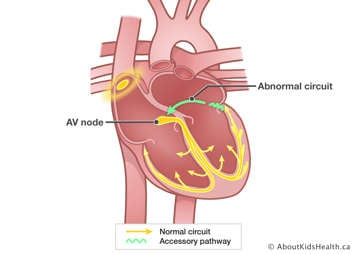
Atrioventricular nodal reentry tachycardia (AVNRT)
Atrioventricular nodal reentry tachycardia involves an extra electrical loop or circuit contained in the AV node. With this tachycardia, the extra pathway allows the heart's electrical impulse to go backwards and start another heartbeat. The fast heart rate occurs because the impulse is moving through the two pathways at the same time.
Patients with this tachycardia tend to have more symptoms than those with AVRT. It tends to be more common in females and often is not the result of a heart condition.
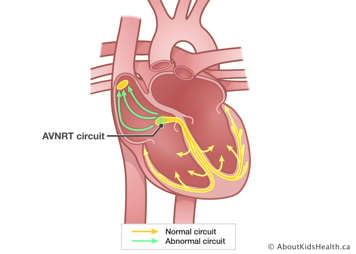
Atrial flutter
This arrhythmia is caused by one or more rapid electrical circuits located in the atrium. As the atria have less time to push blood through to the ventricles, the ventricles may not fill up completely, and so the body may not get enough oxygenated blood.
Atrial flutter can occur in healthy individuals or in connection with a congenital heart defect. It is usually associated with underlying heart disease and can occur after heart surgery.
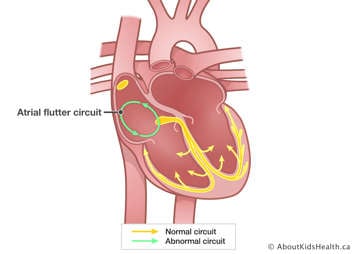
Atrial ectopic tachycardia (AET)
Ectopic means out of place; in this case, it refers to an impulse originating somewhere other than the sinus node. This arrhythmia is prompted by a small abnormal cluster of cells that sends signals to the atrium, causing the atrium to contract before it should and at too fast a rate. There is often a delay in the conduction of the impulse at the AV node.
AET can occur in a healthy heart, with untreated congenital heart disease, or after surgery.
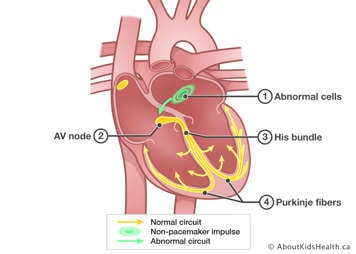
Junctional ectopic tachycardia (JET)
Ectopic means out of place; in this case, it refers to an impulse originating somewhere other than the sinus node. JET results from an abnormal cluster of conduction cells in or near the atrioventricular node that cause the ventricle to contract too quickly.
JET is a very rare type of SVT. It is usually a complication of surgery, although it can occur in a structurally normal heart.
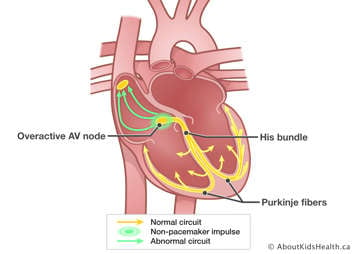
How is tachycardia diagnosed?
A tachycardia can be diagnosed with one of the following:
- electrocardiogram
- Holter monitor
- exercise treadmill study
- electrophysiology study (EPS)
How is tachycardia treated?
Treatment depends on what is causing the tachycardia. Some SVTs can be stopped with certain techniques called vasovagal manoeuvres, including:
- blowing on your thumb like it's a horn
- blowing through a straw with your hand on the end to plug it
- putting ice or cold water on the face for a few seconds
In emergency situations some children with SVT can be helped with medication or by resetting the rhythm of the heart using cardioversion. Depending on the type of SVT and if tachycardia recurs, some children require preventive therapy. Medications can help prevent the episodes from starting, decrease the heart rate during the episode or shorten how long the episode lasts.
A type of electrophysiology study, called an ablation procedure, is another option to treat SVT in children. This approach uses a special wire to either deliver electricity to the heart or to freeze the area in the heart that is causing the arrhythmia.
Additional information
For more information, please read Heart rhythm problems (arrhythmias).
